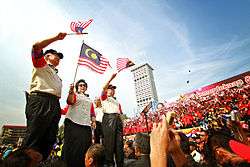Malaysia Day
| Malaysia Day | |
|---|---|
|
2011 Malaysia Day celebration at Merdeka Square, Kuala Lumpur | |
| Official name | Hari Malaysia |
| Observed by | Malaysians |
| Type | National |
| Significance | Marks the establishment of the Malaysian federation |
| Date | 16 September |
| Next time | 16 September 2017 |
| Frequency | annual |
Malaysia Day is held on 16 September every year to commemorate the establishment of the Malaysian federation on the same date in 1963. It marked the joining together of Malaya, North Borneo, Singapore and Sarawak to form Malaysia.
History
The formation of the new federation was planned to occur on 1 June 1963, but was later postponed to 31 August 1963, to coincide with the sixth Hari Merdeka. Several issues related to objections of neighbouring Indonesia and the Philippines to the formation of Malaysia delayed the declaration to 16 September of the same year. The postponement was also done to allow the United Nations team time to conduct referendums in North Borneo (now Sabah) and Sarawak regarding the two states participation in a new federation.[1][2] The formation of Malaysia was made possible with the signing of the International Treaty the Malaysia Agreement 1963 between the United Kingdom, the Federation of Malaya (constituted by 11 states created under the Federation of Malaya Agreement 1957 ; as one component); Sarawak, North Borneo (renamed Sabah) and Singapore of the remaining component States. The Malaysia Agreement 1963 set out the terms and conditions for the component States to be federated under a new constitution into one new nation called Malaysia. It is under this Agreement that the "Malaysia Bill" , (Annexture A), the constitutions of Sarawak, Sabah and Singapore were created by agreement of all the parties (Singapore seceded on 9 August 1965). Through the introduction of the Malaysia Bill to the Malayan Parliament on 9 July 1963, and consent from Tuanku Syed Putra, the Yang di-Pertuan Agong, on 29 August 1963.[1]
Prior to the formation of Malaysia, Sarawak gained its Self-Government Administration on 22 July 1963,[3] while North Borneo (which was renamed Sabah) began Self-Government Administration from the United Kingdom on 31 August 1963,[4] thus coinciding with the sixth anniversary of the Malayan independence.
Since 2010, Malaysia Day has been a public holiday.[5] Prime Minister Najib Razak made the decision after a question-and-answer session at Parliament on 19 October 2009, giving Malaysians two celebrations related to the country's independence.
In popular cultures
Malaysia Forever was a song composed by Bobby Gimby to celebrate the Formation of Malaysia on 16 September 1963. Bobby Gimby received the nickname "The Pied Piper of Canada" after the Prime Minister nicked Gimby as "the Pied Piper from Canada". The song was recorded in Kuala Lumpur and Singapore. It is a folk song with a length of 2 minutes sung by the Choir of the Marymount Vocational School (Singapore). On the days before the merger, it was taught to school children prior to merger and became an instant hit when it was broadcast over the air-waves of all parts of Malaysia.
See also
| Wikimedia Commons has media related to Agreement relating to Malaysia. |
| Wikisource has original text related to this article: |
- Merdeka Day
- Sarawak Self-government Day
- North Borneo Self-government Day
- 20-point agreement (Sabah)
- 18-point agreement (Sarawak)
- History of Malaysia
- Singapore in Malaysia
- Malaysia Forever
References
- 1 2 A marriage that was doomed from the start. New Straits Times. 4 August 2007.
- ↑ Looi Sue-Chern (15 September 2014). "Sabah and Sarawak deserve better, says Guan Eng in Malaysia Day message". The Malaysian Insider. Retrieved 18 September 2014.
- ↑ Frans Welman. Borneo Trilogy Sarawak: Volume 2. Booksmango. pp. 134–. ISBN 978-616-245-089-1. Retrieved 31 August 2013.
- ↑ Frans Welman. Borneo Trilogy Volume 1: Sabah. Booksmango. pp. 159–. ISBN 978-616-245-078-5. Retrieved 31 August 2013.
- ↑ Yeng Ai Chun (19 October 2009). "Malaysia Day now a public holiday, says PM". The Star. Retrieved 16 September 2012.

